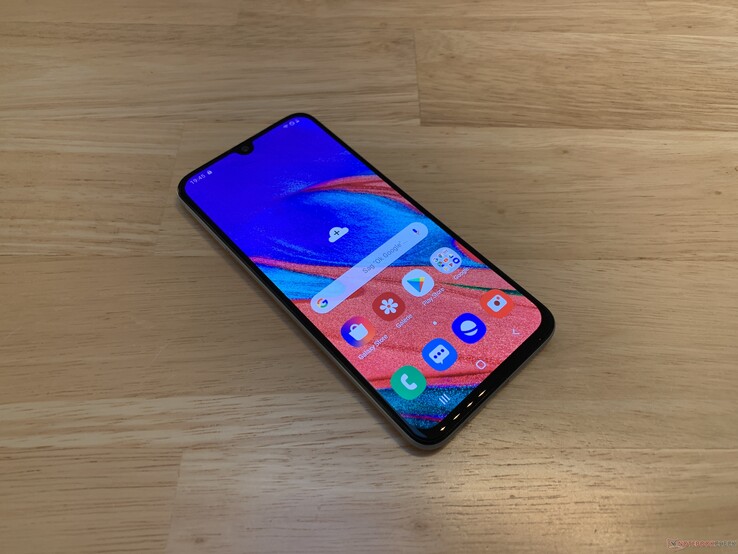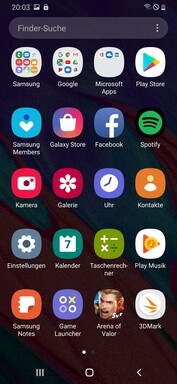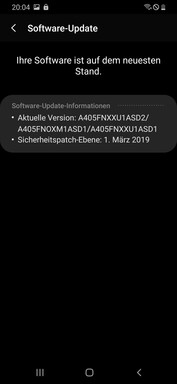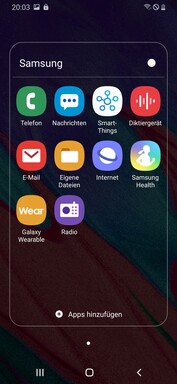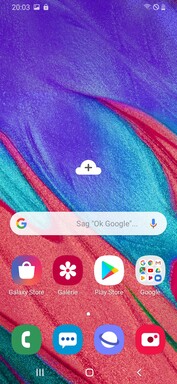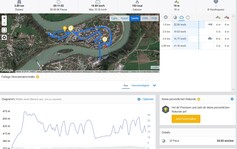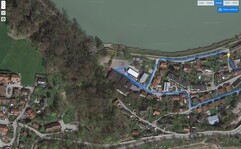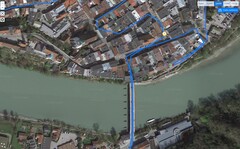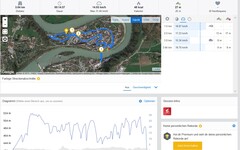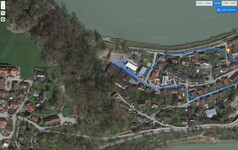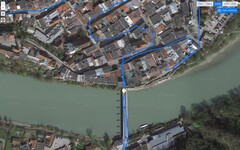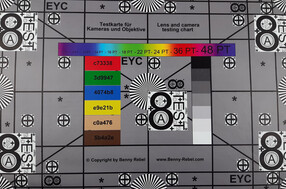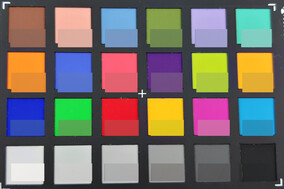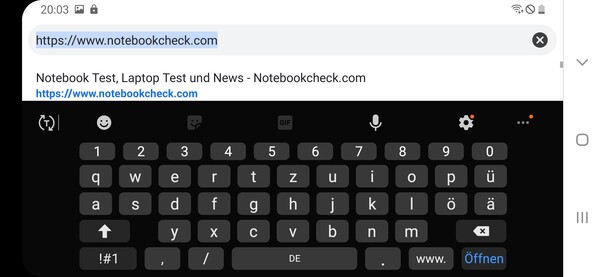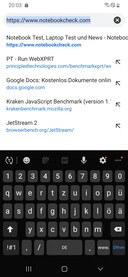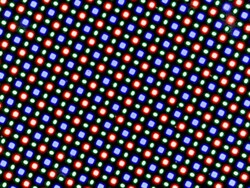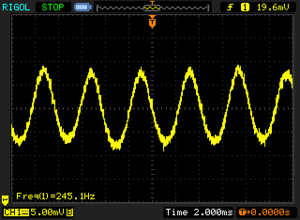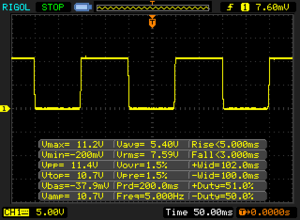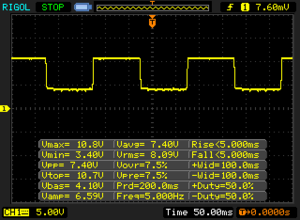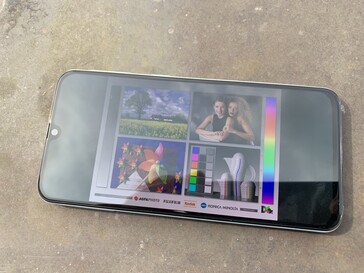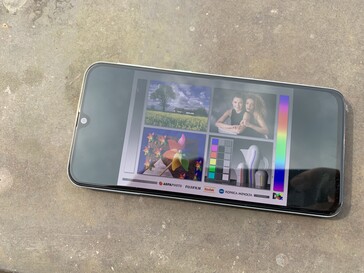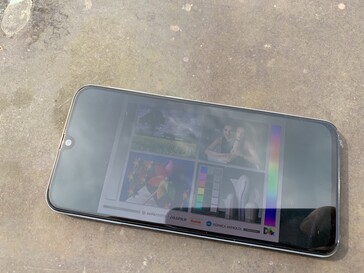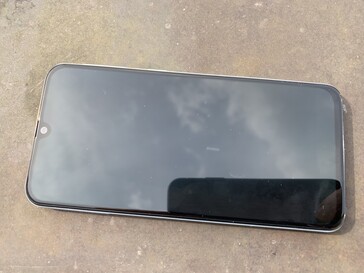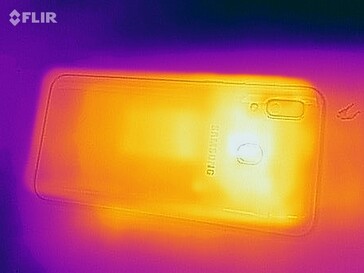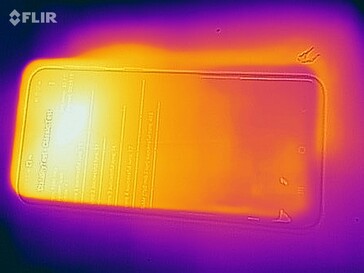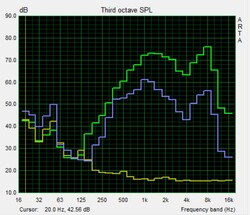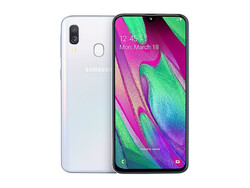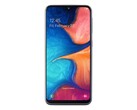Samsung Galaxy A40 Smartphone Review
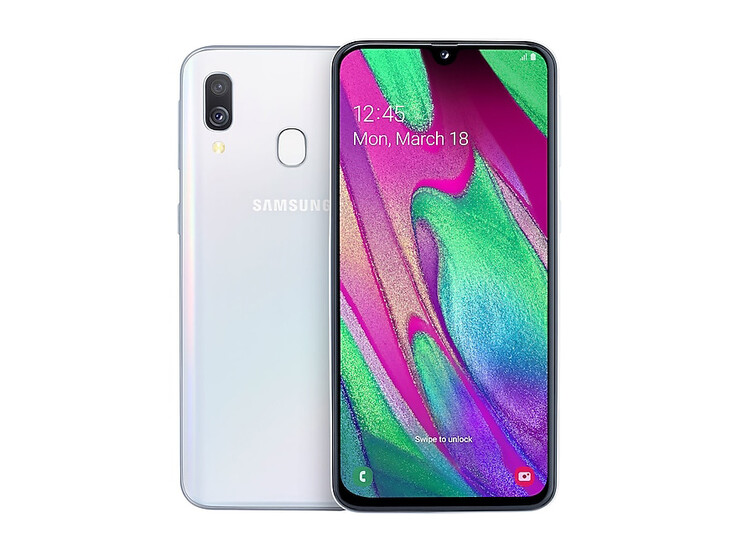
With its new Galaxy-A series, Samsung aims to go with the times: more affordable devices are in demand, but the performance must also be right. This has already worked out in the Galaxy A50, and now we have the more compact and significantly more affordable Galaxy A40 in our test lab. It will be interesting to see whether Samsung has also succeeded in updating its series here.
Samsung is charging 249 Euros (~$279) for the smartphone, and for this you get decent equipment with a fingerprint sensor on the back, a dual-camera system, and 64 GB of storage.
However, other manufacturers also offer pretty smartphones in this price range, such as Xiaomi with its Redmi Note 7 or Gigaset with its GS280.
We also want to know what the real differences are to the Samsung Galaxy M20, which uses the same SoC as the Galaxy A40 and whose price only differs by 30 Euros (~$34). In addition, we compare our test unit with last year's Samsung Galaxy A6, in order to see the exact progress compared to the previous generation.
Case – A high-quality and robust Galaxy phone
The case already shows the differences to the Samsung M series: The Galaxy A40 offers more visual appeal and also a better quality. The glass back shows various effects depending on the color. For example, when you move the white model, it shimmers in all rainbow colors like a pearl. While the blue, black, and coral models also offer some light reflections, they are not quite as spectacular.
The case is quite stable and impervious to pressure, and the workmanship is also on a very high level. Thus the Galaxy A40 greets the buyer without any noticeable edges or gaps between material transitions. In terms of the weight, the Galaxy A40 is also able to convince with a very light 140 grams (~4.9 oz).
There is a so-called Infinity-U display in front, which is able to make do with very small bezels on three sides and a waterdrop notch. The bezel is only slightly wider at the bottom, but compared to the Galaxy A6 (2018), the bezels have become noticeably smaller.
Equipment – A Samsung smartphone with a lot of storage
While at this point, 64 GB of storage and 4 GB of working memory are the usual equipment in this price range, compared to last year, the storage was doubled and there is also 1 GB extra RAM.
We like that you can use two SIM cards and a microSD card at the same time in the Galaxy A40. There is an option to receive FM radio, and NFC as well as the current Bluetooth 5.0 are also on board.
The USB connection transfers data at only USB-2.0 speed, but at least it has the current USB-C format.
Software – The modern One UI including dark mode
Samsung's One UI is also a welcome update, since the operating system now appears fresh and clean. It is based on Android 9, and at the time of our testing, the level of the security patches is March 1, 2019, so they are still fairly current.
You have to live with several preinstalled advertising apps by companies such as Microsoft or Facebook, which unfortunately you cannot delete but only deactivate them. Although they will then not be visible anymore, they still take up storage space.
On the other hand, you can uninstall most of Samsung's own apps that you do not need, such as Samsung Health, Samsung Wearable, or the email app from Samsung.
Communication and GPS – There could have been more LTE bands
The Samsung Galaxy A40 offers the modern 802.11-ac WLAN and also otherwise the most current standards in terms of wireless Internet. With this, it is one of the fastest devices in our comparison field. However, the send and receive rates vary slightly in our test with the Linksys EA8500 reference router.
Our test unit offers the most necessary LTE bands, allowing you to also travel abroad with the smartphone at some point. However, when traveling to far-away countries, you should find out whether the necessary LTE bands are supported by the Galaxy A40, since you will be unable to use LTE there if not.
Around the city, the mobile reception is good indoors.
| Networking | |
| iperf3 transmit AX12 | |
| Samsung Galaxy A40 | |
| Gigaset GS280 | |
| Xiaomi Redmi Note 7 | |
| Samsung Galaxy A6 2018 | |
| Samsung Galaxy M20 | |
| iperf3 receive AX12 | |
| Xiaomi Redmi Note 7 | |
| Samsung Galaxy A40 | |
| Gigaset GS280 | |
| Samsung Galaxy A6 2018 | |
| Samsung Galaxy M20 | |
In terms of locating, according to the GPS Test app, the Galaxy A40 is unable to receive sufficient satellite signals indoors to allow it to determine its location accurately. This situation does not improve even near the window. While it is able to quickly find satellites outdoors, the locating does not succeed there either. This can be due to many factors, but with other smartphones, we did get a satellite reception at the same time and place.
Google Maps, which additionally orients itself using the WLAN networks it can connect to, is able to locate our position quickly and fairly accurately, so we can see that the compass built into the smartphone works well.
With a bike tour we evaluate the ability of the smartphone to determine its location in practice, also taking the Garmin Edge 520 professional navigation device. While the A40 likes to cut off some curves and sometimes places us next to the road in the small alleyways of the old city, the professional device also is not perfect there either. Thus, we are able to attest the Galaxy A40 with acceptable locating capabilities, even if the failure in the GPS Test app remains a flaw.
Telephone Functions and Voice Quality – Booming from time to time
The Telephone app was developed by Samsung itself and offers similar functions as Google's standard app. You start with the telephone keyboard and can then go through the previous calls or contacts, or discover nearby places. VoWiFi and VoLTE are supported, as long as the network operator plays along.
While the voice quality through the earpiece is solid, the voice of our conversation partner booms noticeably at maximum volume. The microphone transfers our voice fairly clearly and without any additional noises. Through the speaker and with hands-free operation, the voice of our conversation partner also sounds slightly booming at high volumes, but otherwise the sound is pleasantly warm and clear. Our voice should neither be too quiet nor too loud, since otherwise our conversation partner either hears nothing or some booming.
Cameras – Dual camera with two focal lengths
Compared to the Samsung Galaxy A6 2018, the camera arrangement has changed significantly. There is now a dual-camera system in the back and a very highly resolving lens in the front. The main camera continues to have a resolution of 16 Megapixels, but there is also a 5-Megapixel lens with a 123° wide angle. With a click inside the camera app, you can change the lens used, resulting in some creative possibilities. At the same time the second lens supports some Bokeh effects, but this only works if it recognizes a face.
As with the Galaxy A6 2018, we basically like the images of the main camera very much, they offer a lot of detail and strong colors. While the dynamic could have been higher and the brightness could have been better in weak-light scenarios, overall the performance of the main camera is not bad for a smartphone of the lower mid-range.
With the main camera, you can record videos at 30 FPS with a maximum resolution of 1080p. Alternatively, you can also record more pixels in the width, in order to create a video with the Galaxy A40 that fills the whole screen. The exposure reacts to changing conditions well and fast without any visible steps, and we also like the image quality overall. Before making the recording, you can select which of the lenses in the back you want to use and decide whether you want more of a wide-angle or a focused image.
The Galaxy A40 is definitely designed as a selfie phone, even if you have to make do without an auto-focus and flash in the front camera. At least you can use the screen as a replacement for the flash. At 25 Megapixels, you can take very high-resolution selfies, but by default selfies are recorded at 12 Megapixels. In bright light or with higher contrasts, it might happen that the edges are not reproduced correctly and the image is overexposed. In addition, you have to be careful to keep the right distance, since otherwise the sharpness is lacking due to the missing auto-focus.
We take a picture of our test chart with the main camera under controlled light conditions in our lab. This shows the slightly unclean reproduction of color areas, and the pictures also look a little dark. Overall, the sharpness is at a good level.
The color chart shows us that colors are reproduced significantly too bright in parts, which becomes particularly visible with green and blue color tones.
Accessories and Warranty – Quick-charger included
In addition to the 10-watt charger and a USB-C cable, there are also a SIM tool and headset in the box. While the latter offers an acceptable sound, it does not really fit securely in everybody's ears.
In its online shop, Samsung offers various covers, such as the gradation cover, which adds a new design element with its color gradation. Those who are looking for a folding wallet cover with a screen protector can also find that.
The warranty on the smartphone is 24 months.
Input Devices and Operation – Fast fingerprint sensor
The touchscreen is very accurate up to the corners and has a sliding-friendly surface that offers only little resistance to the sliding finger. While You can increase the sensitivity in the settings allowing you to use a screen protector, this mode is not suitable for navigation with gloves.
There is a fingerprint sensor on the back. It is only distinguished from the rest of the back by a slightly elevated edge and can therefore be found easily by your finger. It unlocks the device quickly, even from standby. The accuracy convinces us as well. You can also use face recognition to unlock the phone. However, even before you set this up Samsung offers a warning that this method is not quite as secure. At least you can choose between the faster or the more secure method. When it gets too dark, the display brightens automatically to illuminate your face, but our test unit did not succeed in unlocking in complete darkness. Generally the device needs several seconds before the face is recognized, so unlocking the smartphone is faster and more secure via fingerprint.
As in most of the current smartphones, you can find the keys for the menu navigation on the display, and you can also use gestures or rearrange the keys. In terms of the hardware buttons, there is a volume rocker and a standby button on the right side of the case. Your finger can find them easily, and they offer a good pressure point.
Display – Mid-range smartphone with an AMOLED display
As a distinctive feature in the affordable mid-range, Samsung uses an AMOLED display in its devices of the Galaxy-A series. The Galaxy A40 is no exception here and additionally brings a decent 2340x1080 pixels, which corresponds to a slightly expanded Full HD resolution.
Unfortunately, the brightness of the display is not completely convincing in our tests. We measure 370 cd/m² on average and a 379 cd/m² maximum, and an illuminated brightness sensor will not change this. Other devices offer significantly brighter screens here. On the other hand, at 94%, the brightness is evenly distributed in the Galaxy smartphone.
| |||||||||||||||||||||||||
Brightness Distribution: 94 %
Center on Battery: 358 cd/m²
Contrast: ∞:1 (Black: 0 cd/m²)
ΔE ColorChecker Calman: 7.4 | ∀{0.5-29.43 Ø4.77}
ΔE Greyscale Calman: 4 | ∀{0.09-98 Ø5}
142.6% sRGB (Calman 2D)
Gamma: 2.084
CCT: 7078 K
| Samsung Galaxy A40 Super AMOLED, 2340x1080, 5.9" | Samsung Galaxy A6 2018 Super AMOLED, 1480x720, 5.6" | Samsung Galaxy M20 PLS TFT, 2340x1080, 6.3" | Xiaomi Redmi Note 7 IPS, 2340x1080, 6.3" | Gigaset GS280 IPS, 2160x1080, 5.7" | |
|---|---|---|---|---|---|
| Screen | 34% | 4% | 41% | 6% | |
| Brightness middle (cd/m²) | 358 | 453 27% | 452 26% | 541 51% | 472 32% |
| Brightness (cd/m²) | 370 | 459 24% | 445 20% | 540 46% | 473 28% |
| Brightness Distribution (%) | 94 | 93 -1% | 92 -2% | 91 -3% | 87 -7% |
| Black Level * (cd/m²) | 0.41 | 0.33 | 0.28 | ||
| Colorchecker dE 2000 * | 7.4 | 2.6 65% | 5.3 28% | 2.7 64% | 4.7 36% |
| Colorchecker dE 2000 max. * | 12.5 | 9.2 26% | 9.5 24% | 4.6 63% | 9.6 23% |
| Greyscale dE 2000 * | 4 | 1.6 60% | 6.8 -70% | 3.1 22% | 7 -75% |
| Gamma | 2.084 106% | 2.07 106% | 2.23 99% | 2.26 97% | 2.26 97% |
| CCT | 7078 92% | 6356 102% | 8355 78% | 6853 95% | 7730 84% |
| Contrast (:1) | 1102 | 1639 | 1686 |
* ... smaller is better
Screen Flickering / PWM (Pulse-Width Modulation)
| Screen flickering / PWM detected | 245 Hz | ||
The display backlight flickers at 245 Hz (worst case, e.g., utilizing PWM) . The frequency of 245 Hz is relatively low, so sensitive users will likely notice flickering and experience eyestrain at the stated brightness setting and below. In comparison: 53 % of all tested devices do not use PWM to dim the display. If PWM was detected, an average of 8084 (minimum: 5 - maximum: 343500) Hz was measured. | |||
Naturally the contrast is very good, due to the pixels that can be deactivated to produce absolute black. However, the color deviations are relatively high in our tests. You can chose between various display modes, with the "Cinema" mode offering the most accurate color reproduction. Overall, the color reproduction is fairly warm, and only the "Adjustable Display" mode produces a slight blue tint.
The color space coverage is sufficient for a large part of AdobeRGB and DCI P3, so those who calibrate the display will be able to easily judge colors in photos or printed media, for example.
Display Response Times
| ↔ Response Time Black to White | ||
|---|---|---|
| 8 ms ... rise ↗ and fall ↘ combined | ↗ 5 ms rise | |
| ↘ 3 ms fall | ||
| The screen shows fast response rates in our tests and should be suited for gaming. In comparison, all tested devices range from 0.1 (minimum) to 240 (maximum) ms. » 21 % of all devices are better. This means that the measured response time is better than the average of all tested devices (20.2 ms). | ||
| ↔ Response Time 50% Grey to 80% Grey | ||
| 10 ms ... rise ↗ and fall ↘ combined | ↗ 5 ms rise | |
| ↘ 5 ms fall | ||
| The screen shows good response rates in our tests, but may be too slow for competitive gamers. In comparison, all tested devices range from 0.165 (minimum) to 636 (maximum) ms. » 22 % of all devices are better. This means that the measured response time is better than the average of all tested devices (31.6 ms). | ||
Outdoors, the low brightness becomes a problem for the display and you should look for a shady place during sunny days.
As usual for AMOLED displays, the viewing angles are very good. Even if you look at the screen from the side, the image still remains easily recognizable with its original colors.
Performance – A Galaxy smartphone with decent power
In terms of SoC, the Samsung Exynos 7904 is used. The Galaxy A40 does not need to hide with this: Although the Xiaomi Redmi Note 7 offers even more power, compared to the Galaxy A6 2018 or the Gigaset GS280, the advantage is significant. The Galaxy M20 achieved fairly similar performance values.
Things look similar in terms of the graphics performance, where the Galaxy A40 also offers a lot of power for its price range and runs smoothly in everyday operation.
| PCMark for Android | |
| Work performance score (sort by value) | |
| Samsung Galaxy A40 | |
| Samsung Galaxy A6 2018 | |
| Samsung Galaxy M20 | |
| Xiaomi Redmi Note 7 | |
| Gigaset GS280 | |
| Average Samsung Exynos 7904 (5802 - 6923, n=4) | |
| Work 2.0 performance score (sort by value) | |
| Samsung Galaxy A40 | |
| Samsung Galaxy A6 2018 | |
| Samsung Galaxy M20 | |
| Xiaomi Redmi Note 7 | |
| Gigaset GS280 | |
| Average Samsung Exynos 7904 (5269 - 5474, n=4) | |
| Basemark GPU 1.1 | |
| 1920x1080 Vulkan Medium Offscreen (sort by value) | |
| Samsung Galaxy A40 | |
| Average Samsung Exynos 7904 (n=1) | |
| Vulkan Medium Native (sort by value) | |
| Samsung Galaxy A40 | |
| Average Samsung Exynos 7904 (n=1) | |
| 1920x1080 OpenGL Medium Offscreen (sort by value) | |
| Samsung Galaxy A40 | |
| Average Samsung Exynos 7904 (6.21 - 8.72, n=2) | |
| AnTuTu v7 - Total Score (sort by value) | |
| Samsung Galaxy A40 | |
| Samsung Galaxy A6 2018 | |
| Samsung Galaxy M20 | |
| Xiaomi Redmi Note 7 | |
| Gigaset GS280 | |
| Average Samsung Exynos 7904 (101367 - 109906, n=4) | |
| VRMark - Amber Room (sort by value) | |
| Samsung Galaxy A40 | |
| Average Samsung Exynos 7904 (n=1) | |
| Basemark ES 3.1 / Metal - offscreen Overall Score (sort by value) | |
| Samsung Galaxy A40 | |
| Average Samsung Exynos 7904 (241 - 301, n=2) | |
| Average of class Smartphone (205 - 7731, n=34, last 2 years) | |
A significant improvement can be seen in the surfing speed. Compared to the Galaxy A6 2018, the Galaxy A40 performs considerably faster on the Internet. This can also be seen when images on websites are quickly loaded during scrolling and pages are rendered quickly overall.
Demanding HTML-5 pages also pose no problems for the Galaxy A40.
| Jetstream 2 - 2.0 Total Score | |
| Average of class Smartphone (23.8 - 387, n=148, last 2 years) | |
| Average Samsung Exynos 7904 (22.1 - 25.7, n=4) | |
| Samsung Galaxy A40 (Chrome 73) | |
| Samsung Galaxy M20 (Samsung Brwoser 9.2) | |
| Gigaset GS280 (Chrome 72) | |
| Speedometer 2.0 - Result 2.0 | |
| Average of class Smartphone (15.2 - 643, n=121, last 2 years) | |
| Samsung Galaxy A40 (Chrome 73) | |
| Average Samsung Exynos 7904 (19.3 - 24.1, n=4) | |
| Samsung Galaxy M20 | |
| WebXPRT 3 - Overall | |
| Average of class Smartphone (38 - 380, n=31, last 2 years) | |
| Xiaomi Redmi Note 7 (Chrome 72) | |
| Samsung Galaxy M20 | |
| Samsung Galaxy A40 (Chrome 73) | |
| Average Samsung Exynos 7904 (43 - 56, n=4) | |
| Samsung Galaxy A6 2018 (Chrome 64.0.3282.137) | |
| Octane V2 - Total Score | |
| Average of class Smartphone (2228 - 126661, n=196, last 2 years) | |
| Xiaomi Redmi Note 7 (Chrome 72) | |
| Samsung Galaxy M20 | |
| Average Samsung Exynos 7904 (7798 - 9087, n=4) | |
| Samsung Galaxy A40 (Chrome 73) | |
| Samsung Galaxy A6 2018 (Chrome 64.0.3282.137) | |
| Gigaset GS280 (Chrome 72) | |
| Mozilla Kraken 1.1 - Total | |
| Gigaset GS280 (Chrome 72) | |
| Samsung Galaxy A6 2018 (Chrome 64.0.3282.137) | |
| Samsung Galaxy A40 (Chrome 73) | |
| Average Samsung Exynos 7904 (3703 - 5707, n=4) | |
| Xiaomi Redmi Note 7 (Chrome 72) | |
| Samsung Galaxy M20 | |
| Average of class Smartphone (257 - 28190, n=156, last 2 years) | |
* ... smaller is better
The storage is also faster than that of the predecessor. Particularly in terms of its read rates, the internal storage shows significantly better values. However, in the class comparison, it is still only sufficient for a place in the middle of the field.
The microSD card is accessed at the usual speeds, as our test with our Toshiba Exceria Pro M501 reference card shows.
| Samsung Galaxy A40 | Samsung Galaxy A6 2018 | Samsung Galaxy M20 | Xiaomi Redmi Note 7 | Gigaset GS280 | Average 64 GB eMMC Flash | Average of class Smartphone | |
|---|---|---|---|---|---|---|---|
| AndroBench 3-5 | -19% | 43% | 21% | -14% | 32% | 1309% | |
| Sequential Read 256KB (MB/s) | 295 | 208.4 -29% | 300 2% | 283.4 -4% | 281.8 -4% | 277 ? -6% | 2253 ? 664% |
| Sequential Write 256KB (MB/s) | 99.6 | 100.6 1% | 137 38% | 204.7 106% | 104.4 5% | 178.4 ? 79% | 1878 ? 1786% |
| Random Read 4KB (MB/s) | 75.7 | 24.54 -68% | 64 -15% | 82.9 10% | 44.26 -42% | 60.7 ? -20% | 298 ? 294% |
| Random Write 4KB (MB/s) | 13.2 | 10.68 -19% | 44 233% | 16.06 22% | 9.83 -26% | 33.8 ? 156% | 342 ? 2491% |
| Sequential Read 256KB SDCard (MB/s) | 81.2 ? | 81.4 ? 0% | 81.5 ? 0% | 83.2 ? 2% | 78.7 -3% | 77.4 ? -5% | |
| Sequential Write 256KB SDCard (MB/s) | 65.2 ? | 65.7 ? 1% | 65.3 ? 0% | 59.5 ? -9% | 55.7 -15% | 58.3 ? -11% |
Games – Often 60 FPS, but not everything is playable
In games, the Samsung Galaxy A40 generally does well. Some very current games such as "Asphalt 9" cannot be played easily on the device, since the manufacturer considers the graphics hardware as too weak and the game is not displayed in the Google Play Store. Probably there also will be some trouble starting it, if you download the game from elsewhere.
Fortunately, both games accept the 60-Hz mode on the smartphone, allowing you to play quite smoothly. However, some drops are noticeable in high settings. We determine the frame rates using GameBench.
The control via position sensor and touchscreen works without a hitch.
Emissions – Slight warming but no throttling
Temperature
After a prolonged period of load, the case temperatures are fairly elevated. However, as in its larger sibling, the Samsung Galaxy A50, the warming is noticeable but by no means critical in the Galaxy A40. In idle mode, while it is turned on with no significant loads, there is no noticeable warming in the smartphone.
Even after prolonged periods of load, the Galaxy A40 does not throttle. We can find out about this with the battery test of GFXBench, which records the differences in the achieved frame rates while rendering the same sequence thirty times in a row. Since the Galaxy A40 shows no differences worth mentioning, we can assume that the full power is still available even after longer time periods.
(±) The maximum temperature on the upper side is 42.4 °C / 108 F, compared to the average of 35.2 °C / 95 F, ranging from 21.9 to 247 °C for the class Smartphone.
(±) The bottom heats up to a maximum of 41.5 °C / 107 F, compared to the average of 34 °C / 93 F
(+) In idle usage, the average temperature for the upper side is 27.3 °C / 81 F, compared to the device average of 32.9 °C / 91 F.
Speaker
With its mono speaker at the bottom edge, the Galaxy A40 does not get quite as loud as its predecessor, the Galaxy A6 (2018), which also had the more linear sound reproduction across all frequencies. However, we can still attest the A40 with a fairly warm sound, although at maximum volume, it sounded a bit uncomfortable to our ears, since some very high frequencies are overemphasized. Overall, the sound is decent, particularly in this price range.
There continues to be a 3.5-mm audio port in the Galaxy A40, and you also can connect speakers or headphones via Bluetooth. Both work quickly and without any problems, and we also like the sound that is offered.
Samsung Galaxy A40 audio analysis
(+) | speakers can play relatively loud (82.6 dB)
Bass 100 - 315 Hz
(-) | nearly no bass - on average 67.8% lower than median
(+) | bass is linear (0% delta to prev. frequency)
Mids 400 - 2000 Hz
(-) | nearly no mids - on average 67.8% lower than median
(+) | mids are linear (0% delta to prev. frequency)
Highs 2 - 16 kHz
(-) | nearly no highs - on average 67.8% lower than median
(+) | highs are linear (0% delta to prev. frequency)
Overall 100 - 16.000 Hz
(-) | overall sound is not linear (120.2% difference to median)
Compared to same class
» 89% of all tested devices in this class were better, 9% similar, 2% worse
» The best had a delta of 11%, average was 35%, worst was 134%
Compared to all devices tested
» 97% of all tested devices were better, 3% similar, 1% worse
» The best had a delta of 4%, average was 24%, worst was 134%
Samsung Galaxy A6 2018 audio analysis
(+) | speakers can play relatively loud (87 dB)
Bass 100 - 315 Hz
(-) | nearly no bass - on average 26.5% lower than median
(±) | linearity of bass is average (7.6% delta to prev. frequency)
Mids 400 - 2000 Hz
(+) | balanced mids - only 2.8% away from median
(+) | mids are linear (5.5% delta to prev. frequency)
Highs 2 - 16 kHz
(+) | balanced highs - only 3.5% away from median
(+) | highs are linear (6.2% delta to prev. frequency)
Overall 100 - 16.000 Hz
(±) | linearity of overall sound is average (17.4% difference to median)
Compared to same class
» 12% of all tested devices in this class were better, 8% similar, 80% worse
» The best had a delta of 11%, average was 35%, worst was 134%
Compared to all devices tested
» 32% of all tested devices were better, 8% similar, 59% worse
» The best had a delta of 4%, average was 24%, worst was 134%
Power Management – Almost good endurance
Power Consumption
In terms of the power consumption, the Samsung Galaxy A40 does a fairly good job, even if the predecessor was significantly more efficient overall. While the Galaxy A40 uses quite a lot of power, particularly under load, it also offers significantly more performance than the Galaxy A6 (2018).
| Off / Standby | |
| Idle | |
| Load |
|
Key:
min: | |
| Samsung Galaxy A40 3100 mAh | Samsung Galaxy A6 2018 3000 mAh | Samsung Galaxy M20 5000 mAh | Xiaomi Redmi Note 7 4000 mAh | Gigaset GS280 5000 mAh | Average Samsung Exynos 7904 | Average of class Smartphone | |
|---|---|---|---|---|---|---|---|
| Power Consumption | 31% | -1% | 6% | -48% | -16% | -1% | |
| Idle Minimum * (Watt) | 0.8 | 0.81 -1% | 0.94 -18% | 0.61 24% | 1.88 -135% | 1.048 ? -31% | 0.846 ? -6% |
| Idle Average * (Watt) | 1.4 | 1.26 10% | 2.37 -69% | 1.95 -39% | 3.12 -123% | 2.51 ? -79% | 1.444 ? -3% |
| Idle Maximum * (Watt) | 2.3 | 1.3 43% | 2.42 -5% | 2.03 12% | 3.21 -40% | 2.8 ? -22% | 1.627 ? 29% |
| Load Average * (Watt) | 7.4 | 2.87 61% | 3.83 48% | 4.56 38% | 4.34 41% | 5.28 ? 29% | 7.04 ? 5% |
| Load Maximum * (Watt) | 8.6 | 4.82 44% | 5.07 41% | 9.15 -6% | 7.33 15% | 6.61 ? 23% | 11.3 ? -31% |
* ... smaller is better
Battery Life
The 3100-mAh battery does not help the Galaxy A40 in getting decent runtimes. Many devices in this price range, such as the Galaxy M20 or the Gigaset GS280, use an especially powerful battery that results in more weight but also a longer battery life. However, we must say that with 12%, the difference between our test unit and the Gigaset GS280 is not particularly large.
The A40 lasts for 10:43 hours in our WLAN test, which means that you might also get though two work days if you are not always using your smartphone. Under full load, the device lasts for 4:37 hours. This places it at about the same level overall as the Galaxy A6 from last year.
The included charger is rated at 10 watts and needs a good two hours to completely recharge the smartphone.
| Samsung Galaxy A40 3100 mAh | Samsung Galaxy A6 2018 3000 mAh | Samsung Galaxy M20 5000 mAh | Xiaomi Redmi Note 7 4000 mAh | Gigaset GS280 5000 mAh | |
|---|---|---|---|---|---|
| Battery runtime | 1% | 24% | 11% | 12% | |
| Reader / Idle (h) | 28.2 | 26.9 -5% | 31.7 12% | 32.5 15% | |
| H.264 (h) | 13.8 | 14.5 5% | 18.7 36% | 15.7 14% | |
| WiFi v1.3 (h) | 10.7 | 10.1 -6% | 15.5 45% | 12.8 20% | 12 12% |
| Load (h) | 4.6 | 5 9% | 4.8 4% | 4.3 -7% |
Pros
Cons
Verdict – A high quality for the lower mid-range
The Samsung Galaxy A40 is a compact smartphone of the lower mid-range that offers many advantages compared to its predecessor, thanks to a high performance, an elegant case, and a variable camera.
All the other smartphones within its price class now also have to compete with its compact build and light weight, with its case that is robust and high-quality at the same time, and with its high performance capabilities.
Some minor disadvantages result from the dark display, the spotty GPS reception, and the call quality that is only mediocre. However, the large color space of the display, the dual-camera system with its variable focal length, and the solid battery life warrant a clear purchase recommendation for the Samsung Galaxy A40.
An affordable, high-quality and high-performance smartphone of the lower mid-range.
Compared to the more affordable M series, the A40 distinguishes itself with its higher-quality case, the lower weight, and the smaller form factor. Those who are only looking for performance can also grab the M20, since there are no differences in this regard.
Samsung Galaxy A40
- 09/03/2022 v7 (old)
Florian Schmitt




